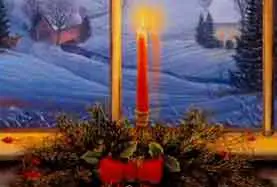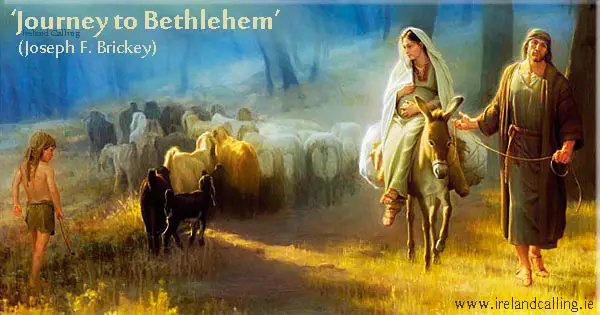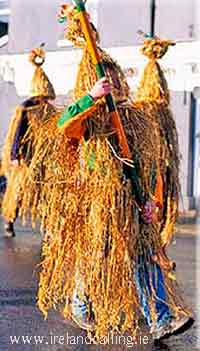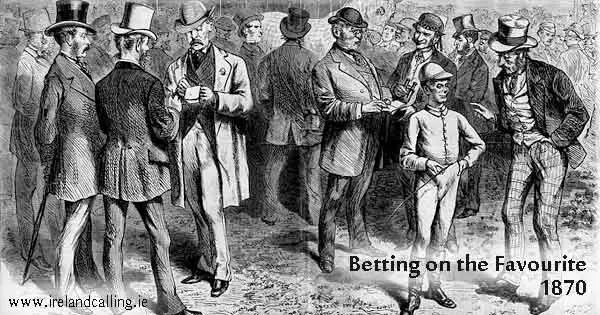
Christmas time in Ireland is when families like to get together and share in the joy of the festive season, exchanging gifts, singing songs and over-indulging in food and drink.
Like in most other countries, the Irish enjoy spending the holidays with their loved ones, but it is also never too long before tensions rise and tempers snap in overcrowded homes, and the ‘perfect family Christmas’ descends into chaos.
The same as the rest of the world really. The little traditions that make Christmas ‘special’.
There are many festive traditions that take place in homes across Ireland each year. Some will be found in other countries as well, while others are uniquely Irish.
Here are a few of the best Irish Christmas traditions.
The White-Wash

Traditionally in Ireland, at the beginning of the four-week period leading up to Christmas (now known as Advent), the men of the family would clean and re-paint the outhouses of the family home.
As the men cleaned outside, the women would do the same inside, so that everything was clean and ready for the Christmas celebrations.
The tradition was originally a practical one, in getting the cleaning and maintenance of the home done in time for the winter months.
However, when Christianity arrived in Ireland, the white-wash was re-defined as the preparation for the arrival of Mary, Joseph and baby Jesus at Christmas.
Very few families in Ireland still partake in this tradition, other than the normal last-minute dusting and hovering that takes place before the arrival of the in-laws for the holiday period.
The Candle in the Window

This is a Christmas tradition that has survived and thrived in modern-day Ireland.
Originally, a candle was placed in the front window of a home, to indicate to others that this was a safe place for priests to perform mass.
Throughout the 17th and 18th century, the British tried to enforce the Church of England religion in Ireland, and even made Catholic masses illegal for a time.
The candles were placed in windows as a signal that a mass would be taking place at the home.
The meaning of the candle in the window has since evolved into a welcome sign for Mary and Joseph. It can also represent the love for a family member who cannot be home at Christmas.

It is now common to see the front windows of Irish homes lavishly decorated with several electrical candles and lights at Christmas time.
One other point to note is that the candle should be first lit by the youngest member of the family, and only extinguished by a girl named ‘Mary’. Fortunately in Ireland, particularly hundreds of years ago, a girl named Mary was never far away.
Midnight Mass
There will be millions of people in the world who only really go to church over the Christmas period, no matter how much they intended to go more.
The Irish are no different, and even though they have a history that is strongly influenced by religion and religious divides, they also sometimes ‘forget’ to go to church every week.
Not on Christmas Eve though. Churches in Ireland are full to the rafters at 12am Christmas morning every year, with the whole community staying up to see in the sacred day with their friends, neighbours and families.
For many, the Midnight Mass is a social event as much as it is religious. Old friends will re-acquaint themselves with a few prayers, a good old chat and an uplifting sing-song of Christmas Carols.
Christmas morning swim
Every Christmas morning in Ireland, thousands of people take part in an unusual and fairly recent tradition; a quick swim in the freezing coastal waters.

Similar practices take place in other countries around Europe, and the Irish are as happy as any to jump right in.
The seas around Ireland are on average about 10°C around Christmas time. Not too cold until you get out and the icy wind sends shivers down your spine.
Still, many Irish people are more than willing to take part in the chilly tradition, often raising money for charity along the way.
The Wren Boy Procession
Each year on St Stephen’s Day (26th December), groups of young men would dress up with blackened faces and straw suits and parade through cities in Ireland singing songs while waving a pole with a dead wren stuck to the top.
This unusual Christmas tradition is one that is uniquely Irish. It is known as the ‘Wren Boy Procession’ or the ‘Hunting of the Wren’.
Its origins are disputed. Some say that a wren cost St Stephen his life when he was hiding from the Romans and it gave away his position and he was killed.
His followers then hunted down and killed the guilty wren and it was labelled ‘evil’ or the ‘devil’s bird’.
The wren was then attached to a pole and the men went door-to-door to request money so that they could bury the ‘evil bird’.

Another theory is that the tradition comes from a story of a group of Irishmen who were in hiding from British soldiers.
They too, had their hiding place exposed when a wren pecked at their drums and made a noise. The men were found and killed by the British soldiers.
Both stories are fairly similar, and today no-one really actually debates which is the correct one.
Nowadays, the Wren Boy Procession is just a fun-filled activity, with the chance to dress up, sing songs and raise money for good causes.
The wren on top of the pole tends to be a fake bird, and the door-to-door collections are more likely to take place in town centres and pubs.
If you fancy having a Wren Boy Procession of your own this year, then here is the song you will need to sing as you parade the ‘evil bird’ through town:

The Wran. The Wran. The king of birds
On St Stephen’s Day it was caught in the furze.
Although he is tiny, his family is great.
Put your hand in your pocket and give us a treat.
On Christmas Day I turned the spit.
I burned my finger, I feel it yet,
So up with the kettle and down with the pan;
Oh, give me a penny to bury the Wran.
On the 26th December each year the Wrenboys take to the road. They visit each house in the locality playing music,dancing,singing and reciting poems.
The style of set dancing in Clare is symbolised by the “battering” or foot tapping that goes on in time with the music.
More foot-tapping music with The Chieftains performing Wren in the Furze from the album Bells of Dublin.
St Stephen’s Day Horse Racing
A trip to the races is high on the agenda for many Irish men on St Stephen’s Day (26th December). St Stephen was after all the patron saint of horses.
Traditionally there are top quality meetings taking place across Ireland on this day each year, particularly at Leopardstown in Dublin.

The race course is a great way to let your hair down after being cramped up in the house for all of Christmas Day.
You can enjoy a few drinks, share a joke with friends, and have a little flutter.
For those that can’t get to the race course for whatever reason, a trip to the local pub to soak in a major sports event from either home or abroad is a more than suitable alternative.
Nollaig na mBean: Women’s Christmas
The twelve days of Christmas officially end on the 6th January; the Feast of the Epiphany.
This was the time in Ireland when the decorations would be taken down, the visitors would leave, and the women would have their own exclusive party!
Nollaig na mBean, meaning Women’s Christmas, takes place on the 6th January every year.
This was a day when women were not responsible for doing any of the housework, taking care of the children or cooking the family meal.
This was Women’s Christmas. The women would traditionally meet at each other’s houses for food and drinks, some relaxation and socialising.
The meals would tend to be baked delicacies such as scones and cream cakes, washed down with a nice pot of tea.
The men would have to stay at home and take down the decorations, see off the visitors and look after the house and children.
The tradition has faded over the last hundred years, but is still followed by some women in Ireland.
Bars and restaurants have tried to revive the waning tradition in recent years with special discounts and deals for parties of women but with limited success.
More about Nollaig na mBean here
More popular articles and videos
The real life mystery of what Maureen O’Hara whispered to make John Wayne look so shocked
Matt Damon winning hearts and minds with charm assault on Ireland
Action hero Tom Cruise was once attacked by an old man in a Kerry pub
Liam Neeson speaks about his late wife in emotional interview
Dating site explains why Irish men make wonderful husband material
Billy Connolly says public should ignore politicians and listen to comedians
Take a look inside Hollywood star Saoirse Ronan’s stunning Irish home
[includeme file=”wp-content/plugins/include-me/videos.html”]

